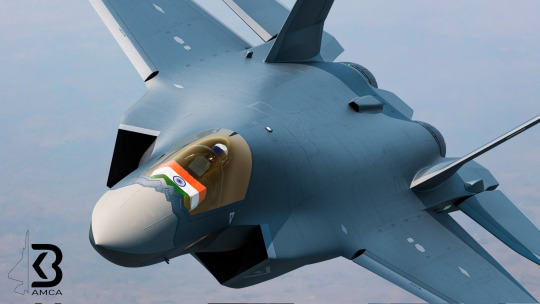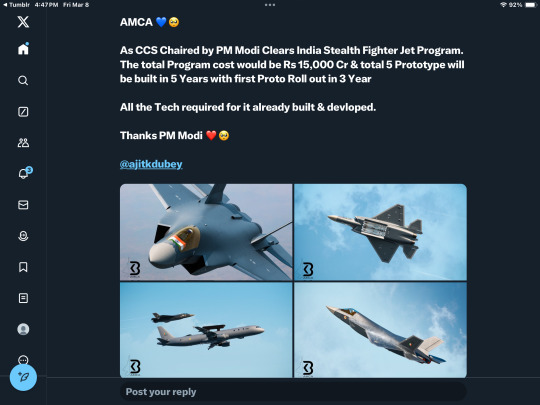#drdo hypersonic missile
Explore tagged Tumblr posts
Text
China is emerging as the global frontrunner in hypersonic missile technology, taking the lead ahead of both the United States and Russia
#china#hypersonic missiles#russia#america#drdo#islamicterrorism#shuksgyan#idf#indiawithisrael#hamas#gaza strip#dr doofenshmirtz#indianarmy#make money online#lebanon
0 notes
Text
India Joins the Hypersonic Missile Club
India’s DRDO testfires Hypersonic Missile: New Delhi, India – November 18, 2024 – India has made a significant stride in its defense capabilities by successfully test-firing a long-range hypersonic missile. The Defense Research and Development Organization (DRDO) conducted the flight test on November 17, 2024, from Dr. APJ Abdul Kalam Island off the coast of Odisha. The missile, designed to carry…
0 notes
Text
How hypersonic weapons are redefining warfare?
youtube
#youtube#hypersonic missiles#hypersonic weapons#drdo#indian army#indian airforce#indian navy#military#military technology#hstdv#hypersonic speed#warfare
0 notes
Text

India approves development of the 5ª generation 'AMCA' fighter
Fernando Valduga By Fernando Valduga 03/07/2024 - 20:03in Military
In a significant move, the Indian Cabinet Security Committee approved the fifth-generation Advanced Medium Combat Aircraft (AMCA) poaching project to be executed by the Defense Research and Development Organization (DRDO).
With an estimated cost of approximately US$ 2 billion, the project will be carried out by the Aeronautical Development Agency of the Defense Research and Development Organization. The goal is to develop poaching and its associated technologies in collaboration with several public and private sector entities. The plan includes the construction of approximately five prototypes within a period of about five years.
According to sources, the project will involve the production of the prototype by industry players, including the public sector company Hindustan Aeronautics Limited.
AMCA ??
As CCS Chaired by PM Modi Clears India Stealth Fighter Jet Program. The total Program cost would be Rs 15,000 Cr & total 5 Prototype will be built in 5 Years with first Proto Roll out in 3 Year
All the Tech required for it already built & devloped.

— Vivek Singh (@VivekSi85847001) March 7, 2024
The government has actively sought the development of national technologies in the defense sector.
The Ministry of Defense predicts that the fifth-generation aircraft project will create numerous employment opportunities and may result in substantial commercial contracts worth millions of dollars for Indian companies. This initiative is expected to generate large-scale employment opportunities.
Under the leadership of Prime Minister Narendra Modi, the Indian Air Force has significantly strengthened its support for Indian fighter aircraft projects. This is evidenced by the government's acquisition of more than 200 light combat aircraft and the approval of engines for the LCA Mark-2 project.

The introduction of the AMCA into operational functions is expected to begin after 2030. The two initial squads are planned to be equipped with GE-414 engines, while discussions are underway for the co-development of more powerful engines for the subsequent squads.
India is expected to introduce more than 200 of these advanced fifth-generation fighters, which will also contribute to the country's ability to develop future generations of jet fighters in the domestic market.
Source: ANI
Tags: Military AviationHAL - Hindustan Aeronautics LimitedHAL AMCA - Advanced Medium Combat Aircraft/Advanced Medium Combat AircraftIAF - Indian Air Force/Air Force of India
Sharing
tweet
Fernando Valduga
Fernando Valduga
Aviation photographer and pilot since 1992, he has participated in several events and air operations, such as Cruzex, AirVenture, Dayton Airshow and FIDAE. He has works published in specialized aviation magazines in Brazil and abroad. He uses Canon equipment during his photographic work in the world of aviation.
Related news
MILITARY
IMAGES: Romania organizes integrated training exercises for allied fighters
07/03/2024 - 16:00
MILITARY
AERALIS reveals common core fuselage model at DIMDEX in Doha
07/03/2024 - 14:00
FIDAE
Crews and aircraft of the Chilean Air Force will be deployed at FIDAE 2024
07/03/2024 - 13:00
BRAZILIAN AIR FORCE
FAB releases music video and documentary in honor of the C-130 Hercules
07/03/2024 - 12:00
HELICOPTERS
Germany will receive its entire new fleet of 60 CH-47F helicopters in eight years
07/03/2024 - 11:00
ARMAMENTS
USAF about to test ARRW hypersonic missile in the central Pacific
07/03/2024 - 09:30
homeMain PageEditorialsINFORMATIONeventsCooperateSpecialitiesadvertiseabout
Cavok Brazil - Digital Tchê Web Creation
Commercial
Executive
Helicopters
HISTORY
Military
Brazilian Air Force
Space
Specialities
Cavok Brazil - Digital Tchê Web Creation
6 notes
·
View notes
Text
https://www.business-standard.com/amp/external-affairs-defence-security/news/women-scientists-played-major-role-in-mission-divyastra-s-success-124031400265_1.html
https://www.business-standard.com/amp/external-affairs-defence-security/news/women-scientists-played-major-role-in-mission-divyastra-s-success-124031400265_1.html
https://www.business-standard.com/amp/external-affairs-defence-security/news/women-scientists-played-major-role-in-mission-divyastra-s-success-124031400265_1.html
#adoration#beautiful model#gorgeous#intimacy#lovers#passion and desire#ps2 nostalgia#sexy bitch#sexy pose#bahajolaf#mexico#tijuana#console gaming#console#skatelife#skatelikeagirl#playstation#skater#adobe#gaming
1 note
·
View note
Text

A 120-second ground test of an Active-Cooled Scramjet Compressor was recently shown for the first time in India by the Defence Research & Development Laboratory (DRDL), which has developed long-duration Supersonic Combustion Ramjet or scramjet-powered Hypersonic technology.
A long-duration Supersonic Combustion Ramjet (Scramjet) engine is being used by the DRDL in Hyderabad, which is a division of DRDO, to explore hypersonic technology.
An important milestone in the development of next-generation hypersonic missiles has been reached with the successful ground test.
A type of cutting-edge weapons known as hypersonic missiles may reach speeds of about 5,400 kilometers per hour, or Mach 5, which is five times the speed of sound.
After China, Russia, and the United States, India is the fourth nation actively exploring hypersonic technology.
#general knowledge#affairsmastery#generalknowledge#india#current events#current news#upscaspirants#upsc#generalknowledgeindia#upsc current affairs#upsc2025#upscpreparation#upsccoaching#iaspreparation#india news#breaking news#world news#news#public news#latestnews#technology#missile#hypersonic#super sonic#engineering#indian science#science news#science#physics#defense
0 notes
Text
Hypersonic India: A Strategic Leap Forward
Hypersonic India: A Strategic Leap Forward A New Era in Indian Defence Capabilities @neosciencehub #neosciencehub #science #research #HypersonicMissile #defence #India #longrange #technology #LRLACM #NSH #missiles
A New Era in Indian Defence Capabilities India has recently achieved significant milestones in defense technology, underscoring its commitment to advancing indigenous capabilities and enhancing national security. Successful Test of Long-Range Hypersonic Missile On November 16, 2024, the Defence Research and Development Organisation (DRDO) successfully conducted the maiden flight test of…
0 notes
Text
India Tests First Hypersonic Missile, Enhancing Defence Capabilities
India’s Defence Research and Development Organisation (DRDO) successfully test-fired the country’s first hypersonic missile off the coast of Odisha. The test, conducted on Dr. APJ Abdul Kalam Island, marks a crucial advancement in India’s military capabilities. Hypersonic missiles, capable of reaching speeds exceeding Mach 5—five times the speed of sound—represent a significant leap in missile…
0 notes
Text
India Tests First Hypersonic Missile, Enhancing Defence Capabilities
India’s Defence Research and Development Organisation (DRDO) successfully test-fired the country’s first hypersonic missile off the coast of Odisha. The test, conducted on Dr. APJ Abdul Kalam Island, marks a crucial advancement in India’s military capabilities. Hypersonic missiles, capable of reaching speeds exceeding Mach 5—five times the speed of sound—represent a significant leap in missile…
0 notes
Text
DRDO carries out successful flight-trial of India’s first long-range hypersonic missile
The long-range hypersonic missile Team News Riveting Bhubaneswar, November 17 Defence Research and Development Organisation (DRDO) conducted a successful flight-trial of India’s first long-range hypersonic missile from Dr APJ Abdul Kalam Island off the coast of Odisha late on November 16, 2024. This hypersonic missile is designed to carry various payloads for ranges greater than 1,500 kms for…
0 notes
Text
India's first hypervelocity expansion tunnel test facility has been developed by IIT Kanpur
- India's first hypervelocity expansion tunnel test facility has been developed by IIT Kanpur. - The Indian Institute of Technology Kanpur (IITK) successfully established India's first hypervelocity expansion tunnel test facility. - It is a major milestone for India, only a few countries have advanced hypersonic testing capability. - This facility can simulate the hypersonic circumstances seen during atmospheric entry by producing flight speeds between 3 and 10 km/s. - This S2 facility is 24 meters long. It was indigenously designed and developed in three years. This facility is commonly called ‘Jigarthanda'. - The funding and support for this facility were provided by the Aeronautical Research and Development Board, and the Department of Science and Technology. - This will be very crucial for ongoing missions of the Indian Space Research Organisation (ISRO) and Defence Research and Development Organisation (DRDO) including Gaganyaan, RLV (Reusable Launch Vehicle), and hypersonic cruise missiles. - With this facility, India will be in a better position to develop advanced hypersonic technologies and systems. Read the full article
0 notes
Text
DRDO successfully conducted a flight-trial of India's first long-range hypersonic missile
#islamicterrorism#shuksgyan#hamas#indiawithisrael#indianarmy#gaza strip#idf#colshukla#drdo#hypersonic missiles
0 notes
Text

0 notes
Photo

“Very Few Countries Have Such Capability”: PM On Hypersonic Test Vehicle PM Narendra Modi congratulated the DRDO after the test of the HSTDV New Delhi: Prime Minister Narendra Modi today congratulated the country's top military growth engine DRDO for the first successful test of a Hypersonic Technology Demonstration Vehicle or HSTDV.
0 notes
Text

India will develop national EFSA radar for its Su-30MKI fleet
Fernando Valduga By Fernando Valduga 09/12/2022 - 14:00in Military
The Defense Research and Development Organization of India (DRDO) will develop a national active electronic scanning radar (AESA) for the Su-30MKI aircraft of the Indian Air Force (IAF).
The state-owned DRDO Electronics and Radar Development Establishment will develop an expanded version of the Uttam radar for the Russian-der hunt in three to four years, wrote the Delhi Defense Review agency, citing sources, adding that flight tests will begin in two years.
DRDO and the Indian Air Force will jointly finance the project, and the latter will provide most of the funding. The IAF gave the green light to the project after evaluating the progress and performance of Uttam.
The service will lend some Su-30 MKIs for the "development, integration, flight testing and certification of the radar," wrote the Delhi Defense Review.

The new version of the radar will have additional transmission and reception modules and a larger power supply, providing improved tracking and search range, Indian Defense Research Wing reported.
The aircraft will also be equipped with a more powerful national flight control, allowing the integration of cruise and air-surface hypersonic missiles.
Meanwhile, DRDO has completed the transfer of technology from Uttam to Hindustan Aeronautics Limited for production. The radar will be integrated into the country's national Mk1A Texas fighter, scheduled to enter service in 2024.
A fire control radar derived from Uttam is also being developed for the Mk1A Tejas and the future Mk2 and Advanced Medium Combat Aircraft Tejas fighters, wrote the Delhi Defense Review.
Source: The Defense Post
Tags: Military AviationIAF - Indian Air Force/India Air ForceAESA RadarsSu-30MKI
Previous news
VIDEO: Air Canada celebrates its 85th anniversary by donating historic aircraft to the Royal Aviation Museum
Next news
Gulfstream flies second fully equipped G700 test aircraft
Fernando Valduga
Fernando Valduga
Aviation photographer and pilot since 1992, he has participated in several events and air operations, such as Cruzex, AirVenture, Dayton Airshow and FIDAE. It has works published in specialized aviation magazines in Brazil and abroad. He uses Canon equipment during his photographic work in the world of aviation.
OMMERCIAL
EXECUTIVE
HELICOPTERS
HISTORY
MILITARY
BRAZILIAN AIR FORCE
SPACE
SPECIALITIES
1 note
·
View note
Text
India eyes hypersonic cruise missile with domestically-made scramjet engine
New Delhi (Sputnik) Sep 08, 2020 After successfully demonstrating an anti-satellite missile last year, Narendra Modi's government has given the green light to the maiden test flight of a prototype of the Hypersonic Technology Demonstrator Vehicle. The state-owned Defence Research and Development Organisation (DRDO) developed the prototype for the test a few years ago. India's state-funded DRDO has flight tested the Hypers Full article>>
9 notes
·
View notes